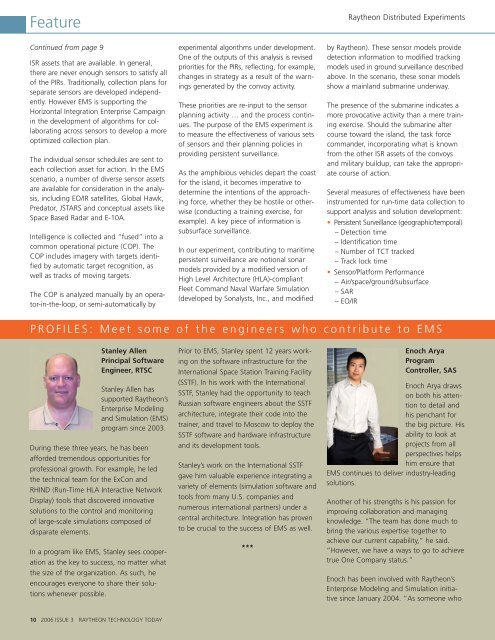Technology Today 2006 Issue 3 - Raytheon
Technology Today 2006 Issue 3 - Raytheon
Technology Today 2006 Issue 3 - Raytheon
You also want an ePaper? Increase the reach of your titles
YUMPU automatically turns print PDFs into web optimized ePapers that Google loves.
Feature<br />
Continued from page 9<br />
ISR assets that are available. In general,<br />
there are never enough sensors to satisfy all<br />
of the PIRs. Traditionally, collection plans for<br />
separate sensors are developed independently.<br />
However EMS is supporting the<br />
Horizontal Integration Enterprise Campaign<br />
in the development of algorithms for collaborating<br />
across sensors to develop a more<br />
optimized collection plan.<br />
The individual sensor schedules are sent to<br />
each collection asset for action. In the EMS<br />
scenario, a number of diverse sensor assets<br />
are available for consideration in the analysis,<br />
including EO/IR satellites, Global Hawk,<br />
Predator, JSTARS and conceptual assets like<br />
Space Based Radar and E-10A.<br />
Intelligence is collected and “fused” into a<br />
common operational picture (COP). The<br />
COP includes imagery with targets identified<br />
by automatic target recognition, as<br />
well as tracks of moving targets.<br />
The COP is analyzed manually by an operator-in-the-loop,<br />
or semi-automatically by<br />
Stanley Allen<br />
Principal Software<br />
Engineer, RTSC<br />
Stanley Allen has<br />
supported <strong>Raytheon</strong>’s<br />
Enterprise Modeling<br />
and Simulation (EMS)<br />
program since 2003.<br />
During these three years, he has been<br />
afforded tremendous opportunities for<br />
professional growth. For example, he led<br />
the technical team for the ExCon and<br />
RHIND (Run-Time HLA Interactive Network<br />
Display) tools that discovered innovative<br />
solutions to the control and monitoring<br />
of large-scale simulations composed of<br />
disparate elements.<br />
In a program like EMS, Stanley sees cooperation<br />
as the key to success, no matter what<br />
the size of the organization. As such, he<br />
encourages everyone to share their solutions<br />
whenever possible.<br />
10 <strong>2006</strong> ISSUE 3 RAYTHEON TECHNOLOGY TODAY<br />
experimental algorithms under development.<br />
One of the outputs of this analysis is revised<br />
priorities for the PIRs, reflecting, for example,<br />
changes in strategy as a result of the warnings<br />
generated by the convoy activity.<br />
These priorities are re-input to the sensor<br />
planning activity … and the process continues.<br />
The purpose of the EMS experiment is<br />
to measure the effectiveness of various sets<br />
of sensors and their planning policies in<br />
providing persistent surveillance.<br />
As the amphibious vehicles depart the coast<br />
for the island, it becomes imperative to<br />
determine the intentions of the approaching<br />
force, whether they be hostile or otherwise<br />
(conducting a training exercise, for<br />
example). A key piece of information is<br />
subsurface surveillance.<br />
In our experiment, contributing to maritime<br />
persistent surveillance are notional sonar<br />
models provided by a modified version of<br />
High Level Architecture (HLA)-compliant<br />
Fleet Command Naval Warfare Simulation<br />
(developed by Sonalysts, Inc., and modified<br />
Prior to EMS, Stanley spent 12 years working<br />
on the software infrastructure for the<br />
International Space Station Training Facility<br />
(SSTF). In his work with the International<br />
SSTF, Stanley had the opportunity to teach<br />
Russian software engineers about the SSTF<br />
architecture, integrate their code into the<br />
trainer, and travel to Moscow to deploy the<br />
SSTF software and hardware infrastructure<br />
and its development tools.<br />
Stanley’s work on the International SSTF<br />
gave him valuable experience integrating a<br />
variety of elements (simulation software and<br />
tools from many U.S. companies and<br />
numerous international partners) under a<br />
central architecture. Integration has proven<br />
to be crucial to the success of EMS as well.<br />
***<br />
<strong>Raytheon</strong> Distributed Experiments<br />
by <strong>Raytheon</strong>). These sensor models provide<br />
detection information to modified tracking<br />
models used in ground surveillance described<br />
above. In the scenario, these sonar models<br />
show a mainland submarine underway.<br />
The presence of the submarine indicates a<br />
more provocative activity than a mere training<br />
exercise. Should the submarine alter<br />
course toward the island, the task force<br />
commander, incorporating what is known<br />
from the other ISR assets of the convoys<br />
and military buildup, can take the appropriate<br />
course of action.<br />
Several measures of effectiveness have been<br />
instrumented for run-time data collection to<br />
support analysis and solution development:<br />
Persistent Surveillance (geographic/temporal)<br />
– Detection time<br />
– Identification time<br />
– Number of TCT tracked<br />
– Track lock time<br />
Sensor/Platform Performance<br />
– Air/space/ground/subsurface<br />
– SAR<br />
– EO/IR<br />
PROFILES: Meet some of the engineers who contribute to EMS<br />
Enoch Arya<br />
Program<br />
Controller, SAS<br />
Enoch Arya draws<br />
on both his attention<br />
to detail and<br />
his penchant for<br />
the big picture. His<br />
ability to look at<br />
projects from all<br />
perspectives helps<br />
him ensure that<br />
EMS continues to deliver industry-leading<br />
solutions.<br />
Another of his strengths is his passion for<br />
improving collaboration and managing<br />
knowledge. “The team has done much to<br />
bring the various expertise together to<br />
achieve our current capability,” he said.<br />
“However, we have a ways to go to achieve<br />
true One Company status.”<br />
Enoch has been involved with <strong>Raytheon</strong>’s<br />
Enterprise Modeling and Simulation initiative<br />
since January 2004. “As someone who

















